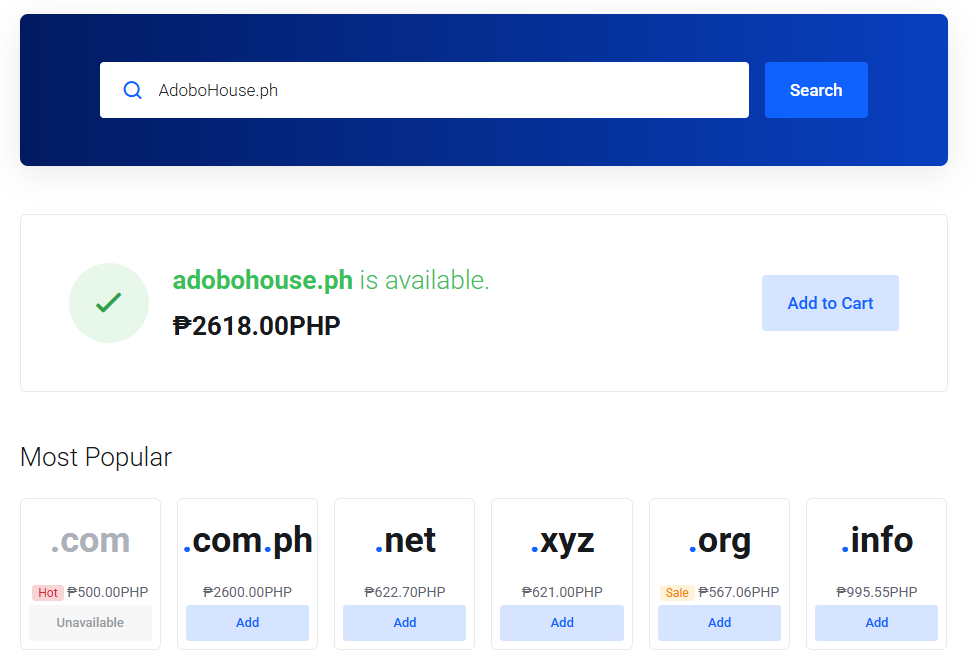Last updated on March 13th, 2025 at 10:06 am
Choosing the right name for your Filipino food business is crucial.
It’s the first thing customers see.
It’s what they remember.
It’s a reflection of your brand.
A great name can attract customers, build brand recognition, and set you apart from the competition.
A bad name?
Well, let’s just say it can be a recipe for disaster.
This article will give you 22 name ideas and the principles behind a great name.
Let’s dive in.
Why Your Filipino Food Business Name Matters
Your business name is more than just a label.
It’s a powerful marketing tool.
A well-chosen name can:
- Attract customers: A catchy and memorable name can pique interest and draw people in.
- Build brand recognition: A unique name helps you stand out and become easily recognizable.
- Communicate your brand: Your name can convey the type of food you serve and the atmosphere you create.
- Create a lasting impression: A good name sticks in people’s minds, making it easier for them to remember and recommend your business.
A weak name does the opposite.
It confuses customers.
It makes you forgettable.
It can even make your business seem unprofessional.
So, choose wisely.
Key Ingredients of a Great Filipino Food Business Name
What makes a name great?
Several factors come into play:
- Relevance: Your name should reflect the type of food you serve (Filipino cuisine).
- Memorability: It should be easy to remember and pronounce.
- Uniqueness: It should stand out from the competition.
- Availability: Make sure the name isn’t already taken (check for trademarks and domain names).
- Target audience: Consider who you’re trying to reach with your business.
22 Filipino Food Business Name Ideas
Here are 22 names, categorized for clarity:
Emphasizing Filipino Heritage:
- Sarap Pinoy: (Sarap means “delicious” in Tagalog) Straightforward and emphasizes the deliciousness of Filipino food.
- Luto ni Lola: (Lola means “grandmother” in Tagalog) Evokes feelings of home-cooked meals and traditional recipes.
- Bayanihan Kitchen: (Bayanihan refers to a spirit of communal unity) Suggests a community-focused dining experience.
- Filipinas Flavors: A classic and direct way to represent Filipino cuisine.
- Mabuhay Eats: (Mabuhay is a Tagalog greeting meaning “long live”) A celebratory and welcoming name.
Focusing on Specific Dishes:
- Adobo House: Specializes in the popular Filipino dish, adobo.
- Lechon Corner: Focuses on the roasted pig dish, lechon.
- Pancit Place: Highlights the noodle dish, pancit.
- Halo-Halo Heaven: Emphasizes the popular dessert, halo-halo.
- Kare-Kare Kitchen: Showcases the rich stew, kare-kare.
Modern and Creative Names:
- Manila Munchies: A catchy and playful name.
- Flavors of the Philippines: A broad name encompassing the diverse Filipino cuisine.
- The Filipino Feast: Suggests a grand and abundant dining experience.
- Island Cuisine: A more general name that can still attract customers interested in Filipino food.
- Tropikal Taste: Evokes the tropical climate of the Philippines.
Location-Based Names (If applicable):
- [Your City/Region] Filipino Food: Simple and direct, good for local targeting.
- [Landmark] Kusina: (Kusina means “kitchen” in Tagalog) Incorporates a local landmark for easy recognition.
Adding a Personal Touch:
- [Your Family Name]’s Kitchen: Adds a personal touch and suggests family recipes.
- [Your Nickname]’s Food: A more casual and friendly approach.
Simple and Direct Names:
- Filipino Food Express: Good for a quick-service restaurant.
- The Filipino Grill: Suitable for a restaurant specializing in grilled dishes.
- Pinoy Delights: A simple and appealing name.
Next Steps: Choosing the Perfect Name
- Shortlist your favorites: Pick 3-5 names that resonate with you.
- Check availability: Make sure the name isn’t already taken (domain name, social media handles, trademarks).
- Get feedback: Ask friends, family, and potential customers for their opinions.
- Make your final decision: Choose the name that best represents your brand and target audience.
Remember, your business name is a crucial part of your brand.
Take your time.
Choose wisely.
And make it delicious!
Why You Should Register a Domain Name (and How to Do It on Truehost.ph)
You’ve got a killer business name.
Fantastic.
But it’s just a name until you stake your claim online. That’s where a domain name comes in.
It’s your digital storefront, your online address, and a critical component of your brand identity. Think of it as the street address for your business on the internet.
Without it, customers will have a hard time finding you.
Why a Domain Name is Essential
A domain name isn’t just a fancy web address. It’s a strategic asset that brings a ton of benefits to your business.
- Professionalism: A custom domain (like yourbusiness.com) looks far more professional than a generic subdomain (like yourbusiness.blogspot.com). It builds credibility and trust with your audience. Think about it: would you trust an email from “[email address removed]” or “[email address removed]” more? The same principle applies to your website.
- Branding: Your domain name reinforces your brand identity. It’s a consistent element that customers see every time they interact with your business online, from your website to your email address. Consistency is key in building a strong brand.
- Memorability: A short, catchy domain name is easier for customers to remember and type into their browsers. This makes it easier for them to find you and come back to your website. Make it easy for people to remember you.
- Search Engine Optimization (SEO): While not a direct ranking factor, a relevant domain name can indirectly improve your search engine rankings. It helps search engines understand what your website is about. Relevance matters in the world of SEO.
- Control: Owning your domain name gives you complete control over your online presence. You’re not tied to any platform or service provider. You own it, you control it.
- Email: A custom domain allows you to create professional email addresses (like [email address removed]). This further enhances your brand image and makes your communication more credible. Professional email = professional business.
Read also: 19 Best Foods to Sell in School in the Philippines: Complete Guide for Student Entrepreneurs
How to Register a Domain Name on Truehost.ph
Truehost.ph is a popular domain registrar in the Philippines. Here’s a step-by-step guide on how to register a domain name with us:

- Visit the Truehost.ph website: Go to www.truehost.ph.
- Search for your desired domain name: Use the search bar on the homepage to check if your desired domain name is available. Be creative if your first choice is taken. Try different extensions (.com, .net, .ph, etc.).
- Choose your domain extension: Select the domain extension that best suits your business. .com is the most popular, but .ph is a good choice for businesses targeting the Philippine market. .ph is your local advantage.
- Add the domain to your cart: Once you’ve found an available domain name, add it to your cart.
- Create an account: If you don’t already have an account with Truehost.ph, you’ll need to create one.
- Review your order: Double-check that you’ve selected the correct domain name and extension.
- Choose your payment method: Truehost.ph offers various payment options, including credit card, PayPal, and bank transfer.
- Complete your purchase: Follow the instructions to complete your purchase.
- Verify your domain: You’ll receive an email with instructions on how to verify your domain ownership. Don’t skip this step!
- Manage your domain: Once your domain is registered, you can manage it through your Truehost.ph account. This includes setting up email addresses, creating subdomains, and configuring DNS settings.
Tips for Choosing the Perfect Domain Name
- Keep it short and memorable: Shorter domain names are easier to remember and type. Short and sweet wins the race.
- Use relevant keywords: If possible, include keywords related to your business in your domain name. This can help with SEO. Keywords can be your friends.
- Choose the right extension: .com is the most popular, but consider other extensions like .ph, .net, or .org depending on your business. .ph for local, .com for global.
- Avoid hyphens and numbers: Hyphens and numbers can make your domain name harder to remember and type. Keep it clean and simple.
- Check for trademarks: Make sure your domain name doesn’t infringe on any existing trademarks. Protect yourself legally.
Read also:
 Web HostingCost-effective shared hosting solutions
Web HostingCost-effective shared hosting solutions Reseller HostingStart your own hosting business without tech hustle
Reseller HostingStart your own hosting business without tech hustle Affiliate ProgramEarn commission by referring customers to our platforms
Affiliate ProgramEarn commission by referring customers to our platforms cPanel HostingHosting powered by cPanel (Mostly user friendly)
cPanel HostingHosting powered by cPanel (Mostly user friendly) Windows HostingOptimized for windows based-applications and sites
Windows HostingOptimized for windows based-applications and sites Domain SearchFind and register available domain names in seconds
Domain SearchFind and register available domain names in seconds All DomainsExplore and register domain extensions across the world
All DomainsExplore and register domain extensions across the world Domain Transfermove your domain to us with zero downtime and full control
Domain Transfermove your domain to us with zero downtime and full control Whois LookupLook up domain ownership, expiry dates and registrar information
Whois LookupLook up domain ownership, expiry dates and registrar information .com DomainSecure the most recognized domain for global credibility
.com DomainSecure the most recognized domain for global credibility VPS HostingScalable virtual servers. Full root access. Faster speed.
VPS HostingScalable virtual servers. Full root access. Faster speed. Managed VPSNot a tech expert? Choose our fully managed VPS server.
Managed VPSNot a tech expert? Choose our fully managed VPS server. Dedicated ServersGet the full power and complete control of your own physical server.
Dedicated ServersGet the full power and complete control of your own physical server.
